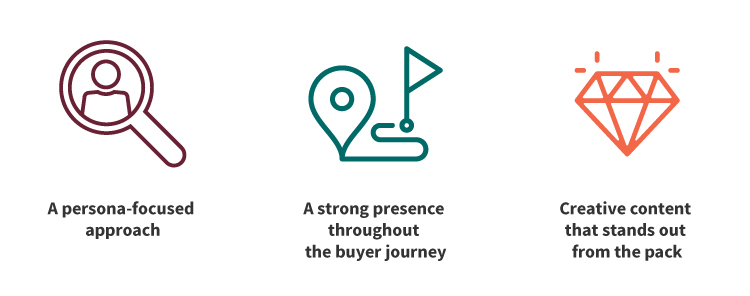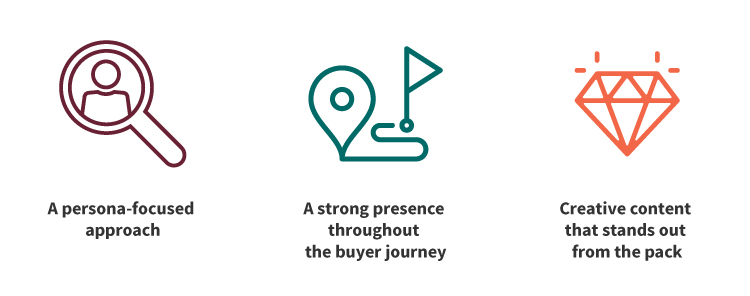
How To Create Content Strategies That Improve The Customer Experience
Your Content Needs To Be Part Of A Holistic Approach
Billions of pieces of content are produced annually. But just as much of that content is generic and indistinguishable, the content strategies that produce it tend to be half-baked or, even worse, nonexistent.
The content craze has reached a point where most businesses are creating content without any real purpose or thought. Content has become an obligation everyone feels they need to fulfill rather than a powerful tool that uses strategy to marry customer needs and business goals.
Truly successful content, the kind that satisfies needs and guides people through the buyer journey, requires a thoughtful content strategy. It also requires a holistic approach that emphasizes three key elements:
- A persona-focused approach
- A strong presence throughout the buyer journey
- Creative content that stands out from the pack
Create Content For Your Personas, Not Yourself
No matter how many times I repeat the refrain “Think user first,” some businesses insist on creating content they want rather than what their customers need.
Don’t get me wrong. Thought leadership is great. Blazing a new trail is admirable. Being a maverick may help conquer the world. But if your content strategy is for an audience of one, you really can’t be upset if it doesn’t connect with prospects or convert customers.
While there’s room in every content strategy for creativity and expression, first and foremost your strategy should be tailored to your audience’s wants and needs. This audience, or your buyer persona, is an amalgamation of identifying characteristics that, when put together, paint a picture of your target customer.
Some information that personas typically cover include:
- Demographic data
- Personality traits and identifiers
- Motivations
- Sources of information
- Goals
- Common challenges during the buying process
- Primary pains that need to be solved
Once you know who your personas are – their goals, the pains they need you to solve, the challenges they face – you can begin to create a content strategy that provides the information they need and introduces a solution to the problems they face.
For instance, let’s say you’re an HVAC company that provides service plans to commercial properties. Maybe your target persona is the property manager and his primary pain is rising heating/cooling costs. You could create an interactive infographic or animated video that shows the lifespan of common parts, how each affects efficiency and how a service plan would reduce costs.
But a content strategy that truly satisfies your personas’ needs is about more than just planning content that will answer their biggest problems. It also needs to address what type of content – the medium, the length, the tone – your persona prefers to consume and therefore will be most impactful.
Let’s revisit the above example. Are most property managers going to take the time to read a whitepaper or e-book on the advantages of an all-inclusive service plan? Probably not. And is that going to be compelling, even for someone whose job is to care about water pumps and gas sensors? Unlikely. But they might find value in a quick-hitting, easy-to-digest visual piece of content.
Tip: Content strategies shouldn’t be a paint-by-number exercise. They should be highly personalized. Try to put yourself in your personas’ shoes and ask yourself:
- What types of content would you like to see?
- What would grab your attention?
- What would help answer your questions and solve your challenges?
Once you begin to answer those questions, your content strategy will start to take shape.
Map Content To The Buyer Journey
Imagine this: You create a grade-A piece of content that people flock to and drool over. It’s highly educational and teaches them everything they need to know about one of your core services. And right at the bottom of that content is a nifty form to schedule a consultation.
But nothing happens.
That grade-A piece sits atop the SERPs and your traffic is off the charts, yet you’re not converting any leads. Why? Because as good as that content is, it represents just one stage of the buyer journey. It’s a single cobblestone of the road to conversion.
This is a common mistake. Many businesses take a piecemeal approach to content strategy, cobbling together some blogs here and a case study there. But there’s seldom any thought of how all these pieces fit together.
If your goal is to convert leads, and not just educate the masses so they can buy elsewhere, you need to take a holistic approach to your content strategy. That means mapping content to the individual stages of the buyer journey.
The simplest and most well-known form of the buyer journey can be seen in the three stages of the traditional sales funnel:
- Education
- Consideration
- Decision-making
However, most marketers agree the sales funnel over-simplifies the buyer journey and doesn’t accurately reflect the complexities of the buying process in the digital age. That experience is much more accurately reflected in the Cyclonic Buyer Journey™.
It doesn’t matter if you cling to the funnel or embrace a modern view, your content strategy needs to be mapped to the journey your customers take – from first click to final conversion. Specifically, you need content that will satisfy the different user needs at each stage.
The biggest upside to an advanced model like the Cyclonic Buyer Journey is that it helps businesses better understand what their customers experience during the purchase process. That is essential in this customer-first climate.
From a content standpoint, though, whether you break that experience into three stages, 13 stages or 30 stages, there’s a lot of overlap in terms of what people are looking for and when. So while it’s advisable to map content to every single stage, a good first step is to ensure you have content that covers:
- Early stages: Information gathering and education.
- Middle stages: Narrowing options, comparing and contrasting choices.
- Late stages: Decision-making and finalizing the deal.
The internet is littered with examples of what type of content represents each stage of the buyer journey. I’m purposely avoiding that type of classification because it trains you to look at content the wrong way. A blog, depending on the topic and approach, can be used at any stage. The same is true of videos and infographics and case studies.
With Google’s recent introduction of search journeys, it’s more important than ever to have content at every stage of the buyer journey. Rather than just show you the same 10 recommendations each time you search for a term, Google will use your previous searches and content engagement to better serve recommendations that match your place in the customer journey.
So, if you had previously searched “pellet grills” and read some articles on what they are and the technology behind them, subsequent searches of the same term might show results for:
- Product comparisons
- Customer reviews
- Product pages where you can make a purchase
Google will also recommend content for a site that you previously spent a lot of time engaging with. If you don’t have content at each stage, you could be handing over traffic to a competitor, and at a time when they’re closer to buying.
Still, mapping content shouldn’t be about creating specific content types for specific stages. It should be about ensuring the customer has what they need every step of the way.
Tip: A common mistake is to treat content like spackle and focus on plugging holes rather than creating a seamless customer experience.
When creating a content strategy, your primary goal should be to provide people with natural next steps and guide them as smoothly as possible through the buying process.
Get Creative
Earlier I stated that a successful content strategy focuses on the needs of your audience, not artistic expression or creative desires. But that’s only partially true.
Yes, it’s essential that your content speaks to your personas and fulfills their needs. However, with so much content readily available, you will need to stand out and grab your audience’s attention with truly great content.
That means being original, being creative and establishing thought leadership.
There’s nothing worse than cookie-cutter content strategies that exist for no other reason than to fulfill some mandate that content be created because, you know, it’s king.
Nothing is gained by writing generic blogs or half-assed content. Actually, it could be argued that more is lost by continually pursuing subpar content – time, money, resources.
Very often, your content is your introduction to a prospect. It’s your opportunity to shine, to get their attention, establish credibility and expertise, and put yourself in the pole position to win their business.
Don’t squander that opportunity. Be creative. Be unique. Make your mark. Here are six tips for making a creative content strategy that will engage your audience, provide them with a great experience and help you stand out.
- Establish a strong, original voice that talks about things in ways your competitors aren’t.
- Go deeper and explore topics in ways you might in a one-on-one conversation.
- Use design to make text assets more appealing and to improve the user experience.
- Mix and match content types to appeal to a wider audience.
- Explore new content mediums and delivery platforms that can improve engagement.
- Take content creation seriously. Strong ROI starts with a good-faith investment.
Tip: It can be challenging to create persona-focused content that maps to the buyer journey and establishes you as a unique voice. If so, make them separate tasks that are baked into your content strategy.
For instance, for every three blogs that focus on known persona needs, allow yourself to write about topics you think matter but nobody else is discussing. This will allow you to focus on creating customer-centric content and establishing thought leadership.
Take A Holistic Approach
Content creation has become a priority for nearly every business. But for it to succeed in guiding people through the buyer journey and converting them into customers, you can’t create that content in a vacuum.
It needs to be a part of a creative, holistic content strategy that focuses on answering your audience’s needs and meeting them at every step of the buyer journey.
At the end of the day, your content strategy should streamline the buyer journey and improve the customer experience, offering natural next steps and guidance.

CEO and Chief Revenue Scientist
Mike Lieberman, CEO and Chief Revenue Scientist
Eliminate Hit-or-Miss Marketing Moves
Get advice, tips, tools and guidance to generate more leads for your company in this weekly email newsletter.



Eliminate Hit-or-Miss Marketing Moves
Get advice, tips, tools and guidance to generate more leads for your company in this weekly email newsletter.














